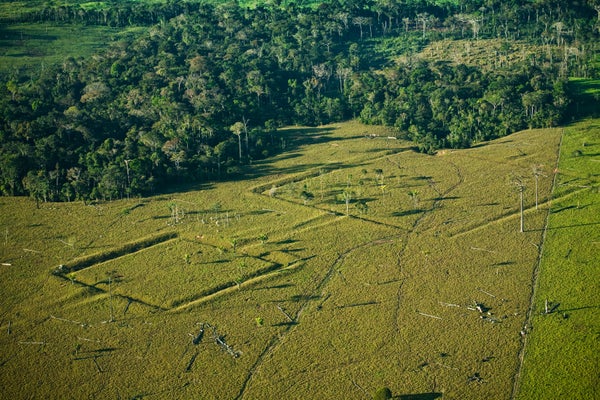In the millennia before European colonizers invaded the Amazon rain forest, throngs of Indigenous people moved mountains of dirt to create some 10,000 yet-to-be-identified earthworks across the region.
That’s according to new research published on Thursday in Science that identifies two dozen sites where massive amounts of dirt formed circular and rectangular geoglyphs, settlements and religious sites. Based on what the researchers knew about such structures, they estimated the huge number of these mysterious constructions that are likely hidden somewhere beneath still unsearched forest. The model supports theories that hold the Amazon, which covers a huge swath of South America, was densely populated before colonization, and it may strengthen political efforts to uphold the modern sovereignty of the forest’s Indigenous inhabitants.
To look for these sites, the researchers found data gathered for other studies of biomass in the northern, central and southern regions of the Amazon rain forest. Those studies relied on a so-called light detection and ranging (lidar) system that bounces an airborne laser off Earth’s surface as it passes overhead, measuring trees’ canopies but also revealing the ground below them. “We thought, ‘Maybe the ground can tell us some stories about the archaeology as well,’” says Vinícius Peripato, a doctoral candidate in remote sensing at Brazil’s National Institute for Space Research and co-lead author of the new study. “At the beginning, it was a complete shot in the dark; we had no idea if we would find anything.”
On supporting science journalism
If you're enjoying this article, consider supporting our award-winning journalism by subscribing. By purchasing a subscription you are helping to ensure the future of impactful stories about the discoveries and ideas shaping our world today.
But in that initial data, which represent less than one tenth of 1 percent of the Amazon’s total area, he and his colleagues found 24 novel earthworks to add to the nearly 1,000 previously known examples. The new sites are between 500 and 1,500 years old, and they include a fortified village, other settlement sites and religious structures, Peripato says. The fortified village had a central plaza and would have been part of a local urban network in the southern Amazon, while the geoglyphs included a cluster of ringlike designs. (Geoglyphs are a type of land art in which dirt is shaped into designs that can be viewed from overhead.)
Next, the researchers used computer modeling to analyze known earthwork sites and predict their spread across the Amazon. That work considered a range of geographical factors such as distance to water, elevation and soil type (sandy soils, for instance, make short-lived earthworks). That work yielded the estimate that there are at least 10,000 earthworks—perhaps even twice that many—hidden across the Amazon. To date, scientists have only found about 1,000 such sites.
The sheer magnitude of that estimate supports previous calculations of a pre-Columbian population of eight million to 10 million in the Amazon, says Eduardo Neves, an archaeologist at the University of São Paulo in Brazil, who was not involved in the new research. He’s confident in those population assessments even if the true number of hidden earthworks isn’t quite 10,000. “To be honest, it’s hard to evaluate that number,” he says of the study’s earthwork prediction. “But I think it’s not off the mark; I think it’s a good number.”
And the experience of archaeologists who study the ancient Maya—and have used lidar to uncover entire networks of cities hidden in the jungle in Central America—suggests that as lidar observations of the area develop, their colleagues now beginning such work in Amazonia will indeed find a trove of new sites. “We thought the Maya area was very well studied, but when we started to do lidar work [there], we had lots of surprises,” says Takeshi Inomata, an archaeologist at the University of Arizona, who was not involved in the Science study. “I think there will be more of those surprises in Amazonia.”
Yet all three researchers, however, say that the importance of the study isn’t so much about the precise number of sites. Rather it’s about the scale of human involvement in the Amazon rain forest. Neves argues that the Amazon is not a “natural” region that is purely produced by plants and nonhuman animals and is instead a “biocultural” one that is defined by the interaction of humans with nature. “There’s a still-common popular perception that the Amazon is a vast, wild expanse, but that’s not really true,” Inomata says. “This study really shows well that there was a lot of involvement of humans in this environment.”
For instance, the scientists also studied which trees were commonly found near earthworks and noted species that include the Brazil nut (Bertholletia excelsa) and the breadnut (Brosimum alicastrum). That analysis suggests people were cultivating these trees—and their tasty offerings—at sites they frequented. It’s both another clue archaeologists can use to target their search for earthworks and a clear form of people leaving their mark on the forest they lived in.
That mark may have real political consequences for their descendants, who are fighting to hold on to the Amazon in the face of agricultural interests and others that could infringe on the forest. Researchers say that the new study supports Indigenous people’s claims of having permeated the Amazon and making it their own, which can strengthen their chances of gaining official stewardship of the forest. “It’s impossible to disentangle the Amazon that we know today from the lives and the history of the Indigenous people who have been living there for millennia,” Neves says. “There’s no future for the forest without a future for the people who have been living there for the last millennia.”
